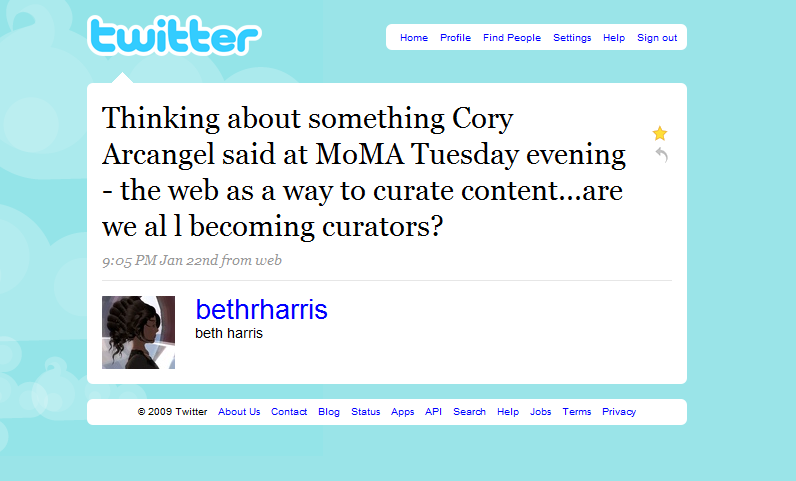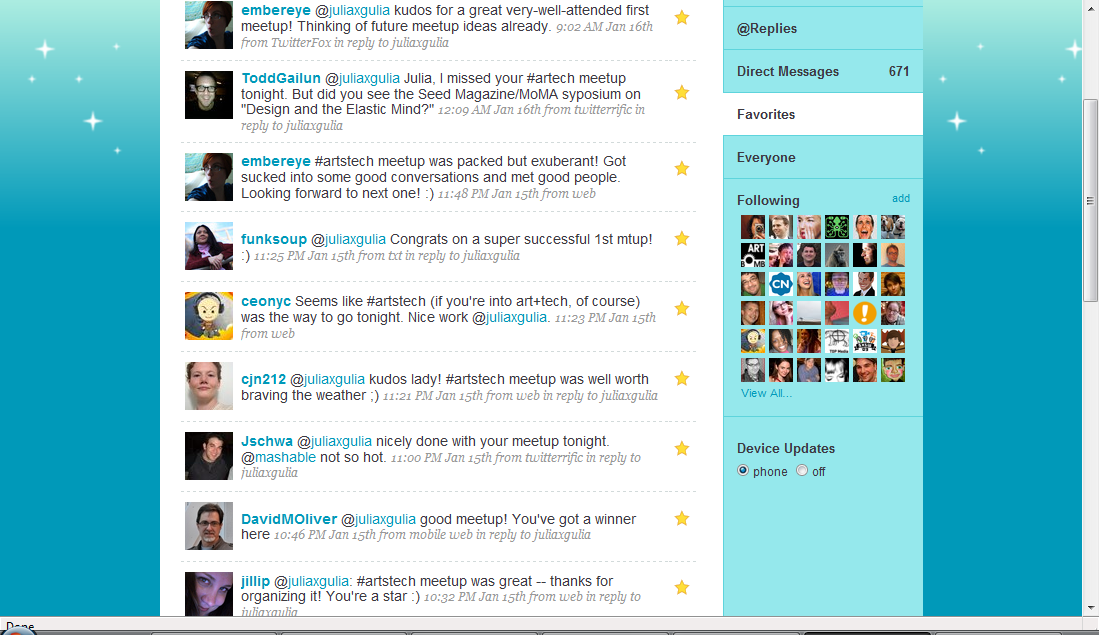List of Presenters for February Arts/Tech Meetup
 Wednesday, February 11, 2009 at 06:02PM
Wednesday, February 11, 2009 at 06:02PM Updated 3/1/09
I've *finally* uploaded the presentation videos from the February Arts, Culture and Technology meetup. The event was held at Ars Nova theater in Hell's Kitchen last Tuesday (2/24/09) and my Dad was kind enough to come and take pictures and video. The sound is a little low and portions of certain presentations have been cut off, but for the most part, I think they came out really well.
Glowlab Gallery
Christina Ray is the founder and Director of Glowlab, an innovative art gallery focused on the convergence of contemporary art, technology and the urban environment. Christina is also the founder of the Conflux Festival here in New York; these days she's working with the Times Square Alliance to bring innovative art to Times Square, and is also serving as an Advisory Board Member for the new 92Y Tribeca.
Website: http://glowlab.com
Twitter Updates: http://twitter.com/glowlab
LinkedIn: http://www.linkedin.com/in/christinaray
Artlog.com
Manish Vora is the co-founder of Artlog.com, a resource for art lovers, artists and institutions. Join the Artlog community at http://artlog.com/signup, follow us at Twitter http://twitter.com/artlog or join the facebook group http://www.facebook.com/group.php?sid=37a1e7e7f47d44a813dd00b6ad8e3928&gid=24335970219
Barry Hoggard
Barry Hoggard is co-creator of ArtCal, an opinionated New York visual arts calendar and magazine, and Culture Pundits, an arts and culture advertising network. He also operates a platform for hosting artist and gallery websites called ArtCat. You can find his social media links on his blog, bloggy.com.
ArtCat - http://www.artcat.com/
ArtCal - http://www.artcal.net/
Culture Pundits - http://www.culturepundits.com/
bloggy.com - http://bloggy.com/
MoMA
Victor Samra is the digital marketing manager at the Museum of Modern Art, reporting to its digital media and marketing departments.
http://twitter.com/MuseumModernArt
http://www.facebook.com/pages/New-York-NY/MoMA-The-Museum-of-Modern-Art/24547752280
http://www.youtube.com/profile?user=MoMAvideos
The Film Society of Lincoln Center
After years of creating websites and advertising copy for major corporations, Amanda McCormick entered the nonprofit arts world last August by accepting a web editor position for the Film Society of Lincoln Center. She has grown the organization’s presence in the social media space via a blog (http://filmlinc.com/blog ), a Twitter presence (http://twitter.com/filmlinc ) and a Facebook fan page (http://filmlinc.com/facebook ), among other outlets.
Jaki Levy
Jaki Levy is the founder of Arrow Root Media, new media production company focused on content development. His online audience initiatives in the field of dance + technology have won awards and grants from the Doris Duke Foundation, Rockefeller Foundation, and Cisco.
company: http://www.arrowrootmedia.com
flickr: http://www.flickr.com/photos/jackomo
linkedin: http://www.linkedin.com/in/jakilevy
skype: jakilevy
Muxtape
Luke Crawford is an interface designer and programmer and the CTO of Muxtape.
Website: http://www.muxtape.com
Blog: http://tlvx.net
Username on Twitter and elsewhere: luke0x
Indaba
Indaba Music is a network of and for musicians. It is now the leading collaboration tool and social network for musicians, with 125,000 musicians in 175 countries. They've been getting a lot of attention recently from places like TechCrunch, Wired, Ars Technica, and even The Colbert Report.
Website: http://www.indabamusic.com/
Sample session: http://www.indabamusic.com/sessions/joepress/50246
Colbert Remix: http://www.indabamusic.com/contests/show/colbert
Mobile Commons
Mobile Commons is a technology provider to cultural institutions. We make it easy for museums, theaters, zoos and aquariums to launch and manage mobile campaigns. Our technology allows you to collect information, send alerts/reminders, raise funds and interact with guests on site.
website: http://mobilecommons.tumblr.com
twitter: http://twitter.com/mobilecommons




